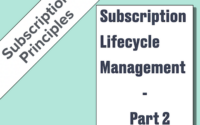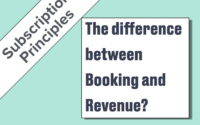What is monetization?
Summary
Monetization transforms a digital activity 💻 into money💰. In a subscription business, monetization generates additional bookings from existing customers.
For example, we can monetize:
- Web traffic generated by customers, 💻
- Data from its commercial activity (with GfK for example)🧾
- Customers’ personal data 💁♂️
- Or directly customers thanks to up-selling and cross-selling commercial offers. 🛒
Monetization is not specific to the subscription business model. However, subscriptions create unique scenarios. Customers may not notice monetization activities. Depending on the business model, it can be a main or additional commercial activity. In some cases, this additional activity can bring in more than the main activity. However, it can present risks.
Let’s look at this in detail.
1. Visible 😐 and non-visible 🫥 monetizations
We can distinguish between visible and non-visible monetizations.
Here are examples of visible monetizations:
- Advertising banners
- Emails with commercial offers
Here are examples of non-visible monetizations:
- Personal data or collected browsing data sold to third parties
- Product placements
Non-visible monetization does not affect the customer experience, but it can affect customer trust.
2. Monetization as a main activity
When a service is free 🆓 or more generally when the site is not transactional, it’s necessary to generate income to cover costs. The monetization activity is the main source of income.
It’s important to monetize all available resources, such as:
- Web traffic with ads (e.g. News site)
- Visitor data
3. Monetization of Freemium: Free-To-Pay 🆓➡️💰
When the principle of free service is combined with the subscription model, we generally speak of Freemium. The basic service is free but the more comprehensive service is paid.
First, we must try to monetize the customer. The goal is to transform the free subscriber into a paying subscriber.
Until the “Free-To-Pay” transformation is done, it’s preferable to avoid other visible monetizations. They could be a source of distraction for the customer, or even a way to go to competition.
For example, if my advertising team sells space to Amazon, it would be possible for my customers to buy my products on Amazon rather than on my site. This would be a very confusing shopping experience.
4. Monetization of paying subscribers 💰➡️💰
When the business model is based on paid subscriptions, monetization is an extra activity to the sale of subscriptions.
Monetization should not be neglected even if it is ancillary. In some cases, it’s possible that it can generate more revenue than the subscription fee.
For example, amusement parks monetize the flow of visitors by selling food and souvenirs. Over the course of a year, the cumulative spending of some subscribers to a park can exceed the price of their annual subscription.
a. Monetization of paying subscribers 🛒➕🛒
In a subscription business, the most common monetization is done on the customer by:
- Up-selling by offering a higher and more expensive subscription
- Cross-selling by offering additional services (subscription-based or not).
This monetization is ideal as the customer’s billing information is already available. These are low-friction transactions.
This is a long term monetization as it increases the ARPU (Average Revenue per User) of the current year and the following ones.
b. Monetization of the loyalty program
For some subscription businesses, it may be relevant to combine the loyalty program and monetization.
For example, some airlines present discounts on hotels and rental cars as benefits offered to loyal customers. This is indeed an advantage but it’s very likely that the airlines are commissioned on these leads.
Another situation: I offer my loyal customers, in limited quantity, an advantage so that they discover it, and later buy it. For example, an amusement park offers a ticket to bypass the lines for the day. Customers who have acquired a taste for this perk will be more likely to buy it later.
5. 🚧 The risks of monetizing subscribers 🚧
a. Unsubscribing
If the customer is “opt-out” for marketing communications. I may be tempted to generate non-commercial traffic in the hope of exposing the customer to a commercial offer. I take the risk of exposing the subscriber to an unsubscribe link.
b. Overexploitation
It’s important to remain reasonable with up-sell and cross-sell offers both in communication and in sales.
When I bombard subscribers with “more comprehensive offers”, it implies their current subscription is inadequate. This can lead to dissatisfaction.
The more up-sells and cross-sells customer takes, the more the subscription price increases. I must be careful not to exceed the acceptable limit or the customer may fail billing or unsubscribe.
👉 Key Takeaways 👈
- In a subscription model, the monetization of subscribers consists of either a Free-To-Pay 🆓 ➡️ 💰conversion or up-sell & cross-sell offers. 🛒 ➕ 🛒
- From the moment there is traffic generated, there are monetization opportunities. You have to be creative.
- Monetization should not be done at the expense of the number of subscribers as the subscription model is entirely based on the number of subscribers.



